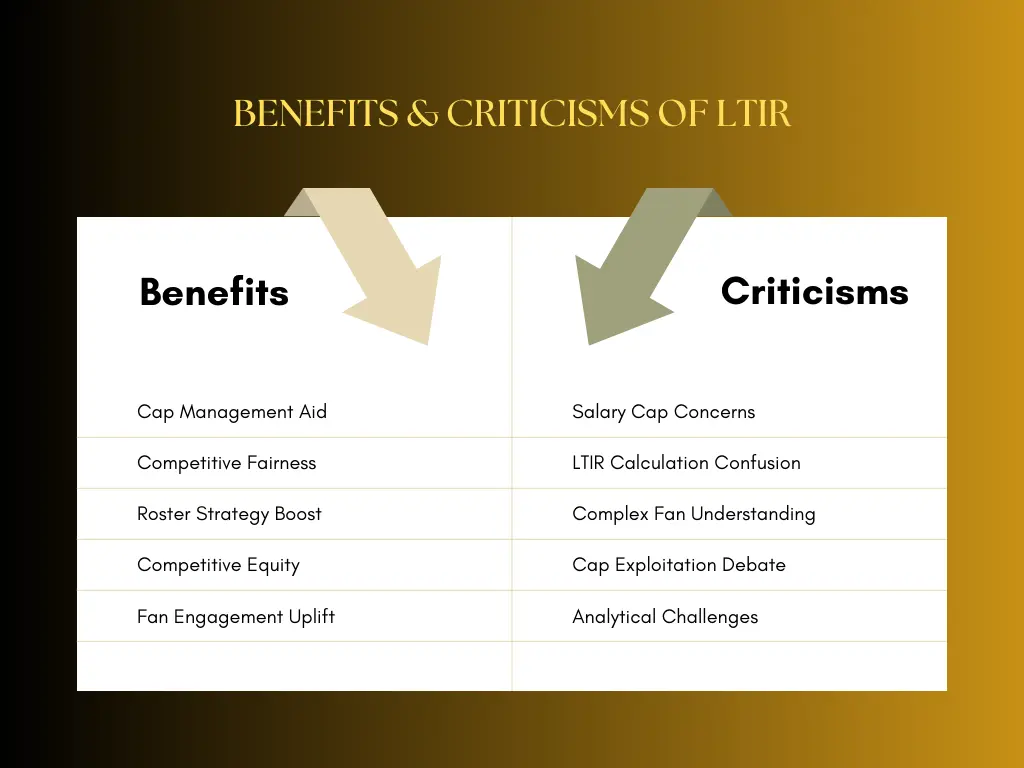The world of professional sports, especially the National Hockey League (NHL), is truly fascinating. From the intense rivalries to the breathtaking skill on display, there’s always something captivating about the game. But what really adds to the intrigue are the behind-the-scenes rules and regulations that govern the sport specially long term injured reserve.
One such rule that has teams scratching their heads is the Long-Term Injured Reserve (LTIR). It’s like a lifeline and a puzzle all at once for NHL teams.
When a player is placed on LTIR, it allows the team to exceed the salary cap by utilizing the injured player’s cap hit. This can provide some much-needed relief for teams dealing with financial constraints.
But here’s where it gets interesting. The rules surrounding LTIR are not as straightforward as they may seem. There are specific criteria that need to be met in order for a player to be eligible for LTIR, including the severity of the injury and the length of time the player is expected to be out of the lineup. Teams must navigate these rules carefully to ensure they are in compliance and maximize their roster flexibility.
In this blog, let’s take a journey together and dive into the intricacies of LTIR. We’ll explore what it is, how it works, and why it actually matters in the world of professional ice hockey. Buckle up and get ready for a wild ride as we unravel the mysteries of this fascinating aspect of the game!
What does LTIR in NHL mean?
To commence our journey, let us first grasp the meaning of LTIR, which stands for Long Term Injured Reserve.
“LTIR is a mechanism in the NHL designed to help teams cope with the absence of key players due to injury.”
However, it is important to note that not all injuries will suffice; certain criteria must be met in order to qualify for LTIR.
- A player must be expected to miss at least 10 NHL Games.
- The absence must span a minimum of 24 days of the NHL season.
These criteria make sure that LTIR is only for players who are dealing with significant and extended injuries and won’t be able to play for a while.

The Misconception of Salary Cap Removal
One of the biggest misunderstandings about LTIR is that it somehow makes a player’s salary cap hit vanish into thin air. But that’s not really how it works, you know? LTIR doesn’t just make a player’s contract disappear. Instead, it gives teams the ability to handle their salary cap situation while dealing with an injury.
The LTIR Pool
So, you might be wondering how teams handle their salary cap with LTIR, right? Well, let me tell you about this thing called the “LTIR Pool”. It’s basically the amount that teams can go over the salary cap when they have a player on LTIR. Cool, huh?
To calculate the LTIR Pool, we need to understand two scenarios:
Scenario 1: Team Cap Compliant on Opening Day Without LTIR
When a team is already cap compliant on opening day, or manages to stay within the cap limit without relying on LTIR, the calculation of the LTIR Pool becomes crucial. Let’s dive into the details!
- LTIR Pool = Cap Hit of the LTIR player – Team’s cap space when the player goes on LTIR
Consider this scenario: a player with a $4 million cap hit is placed on LTIR, but the team only has $100,000 of cap space left. In this case, the LTIR Pool would equate to a whopping $3.9 million ($4 million – $0.1 million).
Teams frequently employ tactical roster maneuvers right before utilizing LTIR to fully capitalize on this pool of resources. It’s all about maximizing the potential and gaining that competitive edge!
Scenario 2: Team Not Cap Compliant on Opening Day
Imagine this: on opening day, if a team finds itself struggling to stay cap compliant without relying on LTIR, they enter a world of calculations. The LTIR Pool, my friend, becomes the ultimate determining factor. It’s all about how much the team exceeds the salary cap. Let me give you an example: let’s say a team kicks off the season with a whopping $3 million cap overage. Now, they choose a player with a $4 million cap hit to include in the LTIR on the opening roster submission. The result? A sweet LTIR Pool worth $3 million. This amount tells us just how far they went beyond the salary cap. Fascinating, isn’t it?
The Importance of Cap Space
When a player is on LTIR, the team stops accumulating cap space. In simpler terms, any unused portion of the LTIR Pool cannot be saved for future use.
This adds another level of complexity to roster management. Teams must carefully strategize and allocate their LTIR Pool throughout the season, creating a thrilling challenge.
The Return of the Player
Wondering what occurs when the injured player is all set to make a comeback? Well, when a player comes off LTIR, the team needs to make sure that their daily cap hit stays within the salary cap. It can be a bit of a balancing act for teams, especially if they have already utilized a substantial portion of their LTIR Pool while the player was out.
Real-Life LTIR Scenarios and Strategic Maneuvers
To illustrate how LTIR works in practice, let’s explore a couple of real-life scenarios. We’ll also delve into the strategic tricks that NHL teams have employed.
Scenario 1: The Injury Shuffle
Imagine a thrilling scenario: a team with a star player, carrying a hefty $6 million cap hit, suddenly faces a severe injury. The team’s current cap space is a mere $500,000, leaving little room for maneuvering.
But wait! Determined to maximize their LTIR Pool, the team concocts a brilliant plan. They orchestrate a series of strategic roster moves just before placing the injured player on LTIR. They shrewdly trade away a player with a $3 million cap hit and deftly demote a rookie with a $2 million cap hit to the minors. These calculated moves leave them with just enough cap space to fully unleash the potential of the LTIR Pool.
The result? A dazzling LTIR Pool worth a whopping $5.5 million ($6 million – $0.5 million). This bold maneuver showcases the team’s tactical prowess and their unwavering commitment to success.
Scenario 2: The Cap Compliant Opening Day
In a different scenario, a team starts the opening day with cap compliance, without utilizing LTIR. However, they have a player with a $5 million cap hit who is anticipated to miss a substantial portion of the season.
The team decides to place this player on LTIR, resulting in the creation of an LTIR Pool of $4.9 million. This strategic maneuver grants the team increased flexibility throughout the season, enabling potential trades or signings of free agents without exceeding the cap. The image below provides a visual representation of the advantages and critiques offered by experts regarding the LTIR rule.
Final Thoughts

In conclusion, Long Term Injured Reserve (LTIR) plays a crucial role in the NHL, acting as a vital mechanism that teams rely on to navigate the complexities of the salary cap when key players are sidelined due to injuries. It provides teams with a much-needed lifeline, allowing them to exceed the salary cap within certain bounds, ensuring fairness and competitiveness within the league.
As avid fans, understanding the nuances of NHL terms like LTIR, AAV, and more not only enhances our enjoyment of the game but also allows us to appreciate the intricate complexity and strategic decision-making involved in managing an NHL team. It gives us a deeper insight into the behind-the-scenes workings of the exciting world of professional ice hockey.
So, the next time you hear about a player being placed on LTIR, you’ll have a clearer and more comprehensive picture of what’s happening behind the scenes, adding to your overall understanding and appreciation of the game. We hope you find this article insightful and informative. Stay connected for many more engaging discussions on the fascinating world of professional ice hockey!
